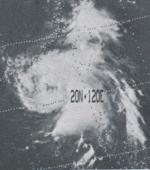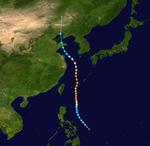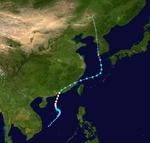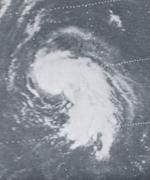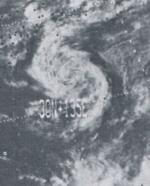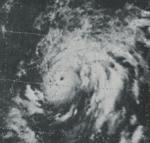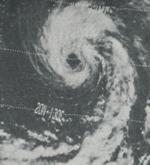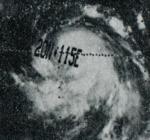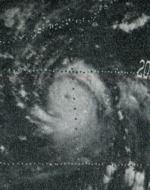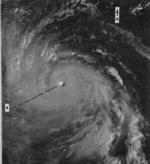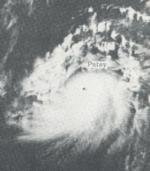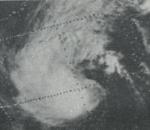| 1973 Pacific typhoon season |
|---|
 Season summary map |
| Seasonal boundaries |
|---|
| First system formed | May 12, 1973 |
|---|
| Last system dissipated | December 27, 1973 |
|---|
| Strongest storm |
|---|
|
| Name | Nora |
|---|
| • Maximum winds | 295 km/h (185 mph)
(1-minute sustained) |
|---|
| • Lowest pressure | 875 hPa (mbar) |
|---|
| Seasonal statistics |
|---|
| Total depressions | 39 |
|---|
| Total storms | 21 |
|---|
| Typhoons | 12 |
|---|
| Super typhoons | 3 (unofficial) |
|---|
| Total fatalities | >1,011 |
|---|
| Total damage | > $7 million (1973 USD) |
|---|
| Related articles |
|---|
| |
|
The 1973 Pacific typhoon season has no official bounds; it ran year-round in 1973, but most tropical cyclones tend to form in the northwestern Pacific Ocean between June and December. These dates conventionally delimit the period of each year when most tropical cyclones form in the northwestern Pacific Ocean.
The scope of this article is limited to the Pacific Ocean, north of the equator and west of the international date line. Storms that form east of the date line and north of the equator are called hurricanes; see 1973 Pacific hurricane season. Tropical Storms formed in the entire west pacific basin were assigned a name by the Joint Typhoon Warning Center. Tropical depressions in this basin have the "W" suffix added to their number. Tropical depressions that enter or form in the Philippine area of responsibility are assigned a name by the Philippine Atmospheric, Geophysical and Astronomical Services Administration or PAGASA. This can often result in the same storm having two names.
Season summary
Systems
25 tropical depressions formed this year in the Western Pacific, of which 21 became tropical storms. 12 storms reached typhoon intensity, of which 3 reached super typhoon strength.[1]
Severe Tropical Storm Wilda (Atring)
| Severe tropical storm (JMA) |
| Tropical storm (SSHWS) |
|
| Duration | June 28 – July 6 |
|---|
| Peak intensity | 110 km/h (70 mph) (1-min) 980 hPa (mbar) |
|---|
Typhoon Anita
| Typhoon (JMA) |
| Category 1 typhoon (SSHWS) |
|
| Duration | July 4 – July 10 |
|---|
| Peak intensity | 130 km/h (80 mph) (1-min) 980 hPa (mbar) |
|---|
Typhoon Billie (Bining)
| Typhoon (JMA) |
| Category 4 typhoon (SSHWS) |
|
| Duration | July 11 – July 19 |
|---|
| Peak intensity | 240 km/h (150 mph) (1-min) 915 hPa (mbar) |
|---|
Tropical Storm Bille, which developed on July 12 east of the Philippines, rapidly strengthened on the 14th and 15th to a 150 mph super typhoon. It tracked due north, fluctuating in intensity for the next 3 days. A building ridge over the Sea of Japan forced Billie to the northwest, where it weakened greatly, first to a tropical storm on the 18th, then to a tropical depression on the 19th as it passed over northeastern China. The storm dissipated on the 20th.
Typhoon Dot
| Typhoon (JMA) |
| Category 2 typhoon (SSHWS) |
|
| Duration | July 11 – July 21 |
|---|
| Peak intensity | 155 km/h (100 mph) (1-min) 975 hPa (mbar) |
|---|
Typhoon Dot struck Hong Kong causing sustained storm force winds, killing one person.[2]
Severe Tropical Storm Clara
| Severe tropical storm (JMA) |
| Tropical storm (SSHWS) |
|
| Duration | July 11 – July 15 |
|---|
| Peak intensity | 100 km/h (65 mph) (1-min) 985 hPa (mbar) |
|---|
Typhoon Ellen
| Typhoon (JMA) |
| Category 3 typhoon (SSHWS) |
|
| Duration | July 16 – July 29 |
|---|
| Peak intensity | 195 km/h (120 mph) (1-min) 940 hPa (mbar) |
|---|
Tropical Storm Fran (Kuring)
| Tropical storm (JMA) |
| Tropical storm (SSHWS) |
|
| Duration | July 23 – July 30 |
|---|
| Peak intensity | 75 km/h (45 mph) (1-min) 1000 hPa (mbar) |
|---|
Typhoon Georgia
| Typhoon (JMA) |
| Category 1 typhoon (SSHWS) |
|
| Duration | August 5 – August 15 |
|---|
| Peak intensity | 130 km/h (80 mph) (1-min) 980 hPa (mbar) |
|---|
Typhoon Iris (Daling)
| Typhoon (JMA) |
| Category 2 typhoon (SSHWS) |
|
| Duration | August 6 – August 21 |
|---|
| Peak intensity | 155 km/h (100 mph) (1-min) 970 hPa (mbar) |
|---|
Tropical Storm Hope
| Tropical storm (JMA) |
| Tropical storm (SSHWS) |
|
| Duration | August 8 – August 13 |
|---|
| Peak intensity | 85 km/h (50 mph) (1-min) 1000 hPa (mbar) |
|---|
Tropical Depression 11W
| Tropical depression (JMA) |
| Tropical depression (SSHWS) |
|
| Duration | August 10 – August 18 |
|---|
| Peak intensity | 55 km/h (35 mph) (1-min) 1008 hPa (mbar) |
|---|
Tropical Storm Joan (Elang)
| Tropical storm (JMA) |
| Tropical storm (SSHWS) |
|
| Duration | August 18 – August 22 |
|---|
| Peak intensity | 85 km/h (50 mph) (1-min) 990 hPa (mbar) |
|---|
Severe Tropical Storm Kate (Goring)
| Severe tropical storm (JMA) |
| Tropical storm (SSHWS) |
|
| Duration | August 20 – August 26 |
|---|
| Peak intensity | 110 km/h (70 mph) (1-min) 975 hPa (mbar) |
|---|
Tropical Depression 14W
| Tropical depression (JMA) |
| Tropical depression (SSHWS) |
|
| Duration | August 28 – September 3 |
|---|
| Peak intensity | 55 km/h (35 mph) (1-min) 1002 hPa (mbar) |
|---|
Typhoon Louise (Huling)
| Typhoon (JMA) |
| Category 1 typhoon (SSHWS) |
|
| Duration | August 30 – September 6 |
|---|
| Peak intensity | 140 km/h (85 mph) (1-min) 975 hPa (mbar) |
|---|
Typhoon Marge (Ibiang)
| Typhoon (JMA) |
| Category 1 typhoon (SSHWS) |
|
| Duration | September 10 – September 15 |
|---|
| Peak intensity | 150 km/h (90 mph) (1-min) 965 hPa (mbar) |
|---|
Main article: Typhoon Marge (1973)
Hainan, Qionghai Jiaji town recorded a minimum central pressure of 937.8 hPa when Marge landfall. Marge killed 903 people in Hainan. Marge made its final landfall in Thanh Hoa, Vietnam on September 15.
Typhoon Nora (Luming)
| Typhoon (JMA) |
| Category 5 super typhoon (SSHWS) |
|
| Duration | October 1 – October 10 |
|---|
| Peak intensity | 295 km/h (185 mph) (1-min) 875 hPa (mbar) |
|---|
Main article: Typhoon Nora (1973)
The monsoon trough spawned a tropical depression east of the Philippines on October 1. Under weak steering currents, it meandered westward, where favorable conditions allowed for it to strengthen, first to a tropical storm on the 2nd, then to a typhoon on the 3rd. Nora continued to the northwest, and explosively deepened on the 5th and 6th to a 185 mph super typhoon. At the time, it had a minimum central pressure of 877 millibars, the lowest pressure on record at the time and currently tied for 9th. The typhoon weakened as it headed to the northwest, and struck northeastern Luzon on the 7th as a 115 mph typhoon. Nora continued to the northwest, weakening to a minimal typhoon as it hit southeast China on the 10th. The typhoon caused 18 fatalities, with over $2 million in damage.
Typhoon Opal
| Typhoon (JMA) |
| Category 1 typhoon (SSHWS) |
|
| Duration | October 3 – October 8 |
|---|
| Peak intensity | 140 km/h (85 mph) (1-min) 970 hPa (mbar) |
|---|
Typhoon Patsy (Miling)
| Typhoon (JMA) |
| Category 5 super typhoon (SSHWS) |
|
| Duration | October 5 – October 15 |
|---|
| Peak intensity | 260 km/h (160 mph) (1-min) 895 hPa (mbar) |
|---|
Typhoon Ruth (Narsing)
| Typhoon (JMA) |
| Category 2 typhoon (SSHWS) |
|
| Duration | October 11 – October 19 |
|---|
| Peak intensity | 165 km/h (105 mph) (1-min) 960 hPa (mbar) |
|---|
27 people were killed when Typhoon Ruth crossed Luzon on October 15 and caused $5 million in damage. Ruth continued to the northwest, and hit Hainan Island and Quang Ninh, Vietnam on the 19th, respectively.
Ruth had the similar path to the Typhoon Sarika in the same time in 2016.
Severe Tropical Storm Sarah
| Severe tropical storm (JMA) |
| Tropical storm (SSHWS) |
|
| Duration | November 9 – November 12 |
|---|
| Peak intensity | 100 km/h (65 mph) (1-min) 985 hPa (mbar) |
|---|
On November 12 this system emerged in the Bay of Bengal and became Tropical Cyclone 37-73.[1]
Severe Tropical Storm Thelma
| Severe tropical storm (JMA) |
| Tropical storm (SSHWS) |
|
| Duration | November 13 – November 18 |
|---|
| Peak intensity | 100 km/h (65 mph) (1-min) 990 hPa (mbar) |
|---|
Severe Tropical Storm Vera (Openg)
| Severe tropical storm (JMA) |
| Tropical storm (SSHWS) |
|
| Duration | November 18 – November 26 |
|---|
| Peak intensity | 95 km/h (60 mph) (1-min) 990 hPa (mbar) |
|---|
One of the strongest tropical cyclones to hit Visayas when it entered on November 20, although the system didn't reach typhoon status. Tropical Storm Openg affected around 3.4 million people.[3]
Storm names
Western North Pacific tropical cyclones were named by the Joint Typhoon Warning Center. The first storm of 1973 was named Wilda and the final one was named Vera.
Agnes Bess Carmen Della Elaine Faye Gloria Hester Irma Judy Kit Lola Mamie Nina Ora Phyllis Rita Susan Tess Viola Winnie
| Alice Betty Cora Doris Elsie Flossie Grace Helen Ida June Kathy Lorna Marie Nancy Olga Pamela Ruby Sally Therese Violet - Wilda 1W
| - Anita 2W
- Billie 4W
- Clara 3W
- Dot 5W
- Ellen 6W
- Fran 7W
- Georgia 8W
- Hope 9W
- Iris 10W
- Joan 12W
- Kate 13W
- Louise 15W
- Marge 16W
- Nora 17W
- Opal 18W
- Patsy 19W
- Ruth 20W
- Sarah 21W
- Thelma 22W
- Vera 23W
Wanda
| Amy Babe Carla Dinah Emma Freda Gilda Harriet Ivy Jean Kim Lucy Mary Nadine Olive Polly Rose Shirley Trix Virginia Wendy
|
Philippines
| Atring | Bining | Kuring | Daling | Elang |
| Goring | Huling | Ibiang | Luming | Miling |
| Narsing | Openg | Pining (unused) | Rubing (unused) | Saling (unused) |
| Tasing (unused) | Unding (unused) | Walding (unused) | Yeyeng (unused) | |
| Auxiliary list |
| | | | Anding (unused) |
| Binang (unused) | Kadiang (unused) | Dinang (unused) | Epang (unused) | Gundang (unused) |
The Philippine Atmospheric, Geophysical and Astronomical Services Administration uses its own naming scheme for tropical cyclones in their area of responsibility. PAGASA assigns names to tropical depressions that form within their area of responsibility and any tropical cyclone that might move into their area of responsibility. Should the list of names for a given year prove to be insufficient, names are taken from an auxiliary list, the first 10 of which are published each year before the season starts. This is the same list used for the 1969 season. PAGASA uses its own naming scheme that starts in the Filipino alphabet, with names of Filipino female names ending with "ng" (A, B, K, D, etc.).
Season effects
This table will list all the storms that developed in the northwestern Pacific Ocean west of the International Date Line and north of the equator during 1973. It will include their intensity, duration, name, areas affected, deaths, missing persons (in parentheses), and damage totals. Classification and intensity values will be based on estimations conducted by the JMA, however due to lack of information around this time sustained winds were recorded by the JTWC. All damage figures will be in 1973 USD. Damages and deaths from a storm will include when the storm was a precursor wave or an extratropical low.
See also
References
External links


